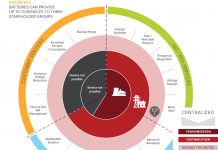![Click for larger verion StorageRTE[1].PNG](http://www.altenergystocks.com/wp-content/uploads/2017/08/StorageRTE_1_.png)
|
It’s almost a cliché that there’s a “friendly debate” pitting utilities against renewable energy. But concerns on the utility side of the table are real: intermittency, potential destabilization at the feeder level, non-baseload, and peaks in generation that don’t necessarily match demand peaks. Today’s power infrastructure involves unpredictability in both supply and demand that is extremely difficult to manage. The choice comes down to two options: over-generate so as to not undersupply, or find ways to better match up supply and demand.
“To balance the grid and keep it in a stable condition, you’re going to need energy storage,” said Doug Staker, VP of business development for Demand Energy. “Every customer interaction, every presentation, one question I’m getting now: what can you do to help me with storage?” He said there’s a “huge lack of information and education” about whether energy storage is ready and in what form (e.g. which technology to use, and whether it’s centralized vs. distributed) “People really want to understand how to integrate energy storage into a variety of applications.”
As more renewable energy comes into the power mix, “high-response energy storage seems to be the way,” added Chris Wheaton, CFO of Energ2. “We think storage is an equivalent leg of the chair” alongside solar and wind energy generation.
“In general energy storage is a good thing except that it is not cost-effective for bulk energy storage,” counters Mahesh Morjaria, VP of PV technology applications at First Solar. If the goal is to manage variable energy generation, Morjaria suggests, then the whole grid can act as energy storage, if managed properly. “When part of the resource is not available or generating, other resources are able to provide the load,” Morjaria said. “That’s the beauty of it, in a more cost-effective manner.” Storage too can provide grid flexibility, agreed Morjaria, but it’s simply not yet cost-effective enough.
What’s It For?
Discussing large-scale energy storage depends on what problems are being solved. “People forget what energy storage is: an enabler,” explained Erick Petersen, VP of marketing at Demand Energy. It’s not that grid-scale energy storage *can’t* be deployed it’s a question of what do you want do with it, whether it’s achieve true grid stability, or flatten loads to reduce peak congestion, or provide ancillary services. “The benefits stack up the highest as you move the edge of the grid,” he said. “People get lost in the debate whether it should be grid-scale, which battery is right the answer is, ‘All of it,’ depending on the problem you’re trying to solve.”
Reliability and Flexibility
Germany is widely accepted as having a much more robust incorporation and management of renewable energy generation. But even there, many believe the nation’s energy overhaul means storage is a matter of not if but when. Wheaton thinks “the jury’s still out whether Germany will have an energy storage program.” Rick Luebbe, CEO of Energy2, points to a Sandia Labs calculation that problems start emerging at a 20 percent renewables mix at which point storage has to enter the discussion.
Germany has been able to accommodate roughly 22 percent of a renewables mix, mostly variable wind and solar and they’re doing it by leveraging flexibility in their grid “without going out and acquiring a whole bunch of storage,” Morjaria points out. Similarly, California’s 33 percent renewables target won’t rely on building massive amounts of bulk energy storage. In both cases, “they’re figuring out other ways to achieve grid flexibility,” he said.
In California the difference between trough and peak load on a summer day can be 20 gigawatts, Staker pointed out. “People talk about the [grid] having flexibility and capability to absorb excess generation and that’s true,” he said. “But more system saturation becomes more problematic,” once you have to start doing things like firming up wind power with gas peakers that by definition want to run in a steady-state condition and not vary up and down to plug intermittent gaps.
Demand Response
“Demand response has been the cure-all for all kinds of system challenges,” Staker said. He recalled an effort from Baltimore Gas & Electric with a demand/response plan to reimburse customers for turning off their air conditioners for a few hours during critical peak events. But the system was one-way and radio-based, and closed-loop no way to really know who responded. So an urban secret spread: wrap your AC in tinfoil to block the signals, and cash in the reimbursement. That, he said, illustrates a problem with demand/response: “at the end of the day, customers can just opt out.”
If response time is the target, hydro and possibly compressed air make sense, balancing on a 24-hour cycle, says Luebbe. But either of those options are selective based on geography. For shorter-timeframe needs, electrochemical storage comes into play, with multiple technologies to choose from (lead/acid, lithium-ion, flow, molten, ultracapacitors, hybrid configurations). For balancing solar power into a facility or a grid, lead-acid batteries “will probably be just fine,” he said, while flow and molten batteries will emerge at point-of-use to balance intermittent power from a local grid (e.g. cell-phone towers).
Still, Morjaria thinks the costs for energy storage still aren’t low enough to make it feasible for this time-shifting. Even if there’s a significant difference in the cost of every kilowatt-hour that can be fed into and pulled out of the grid, adding costs associated with energy storage eliminates those potential gains. “In California they’re talking about PPAs on the order of $85/MWh [$0.08/kWh]. That’s what they expect from solar energy,” he points out. (Note that a recent deal in New Mexico was for less than six cents/kWh, and ironically for a First Solar [FSLR] project.) Storing energy and pumping it out adds to that cost Morjaria ballparks it at $0.20/kWh which quickly snuffs out any price arbitrage.
Frequency Regulation
Morjaria did acknowledge one area where energy storage is indeed viable: frequency regulation. Constantly adjusting power input to offset increased/decreased demand and keep frequency constant, responding very fast with charging and deploying energy in very short cycles “that’s where energy storage has an interesting role to play,” Morjaria said. A123 and Beacon Power have explored that in NY ISO and other places, FERC has tweaked regulation to support it, and “it seems to be making some sense,” Morjaria noted. But that isn’t necessarily a practice that depends on variable generation from renewables.
Frequency response can stretch out some power output at the expense of some quality, but power coming from renewable sources “is simply not high enough for most independent power producers and transmission to handle,” said Chris Wheaton, CFO of Energ2.
What It Cos
ts
The big question in energy storage, Wheaton says, boils down simply: what does it cost to build more generation (to oversupply), vs. how to store and manage energy? Today it’s more “economically rational” to build more generation, whether it’s solar or wind or even coal, he noted. As energy storage technology costs come down and as there is better understanding and calculation of externalized costs, such as societal impacts “we will see those lines cross, and more utilities will go to energy storage as a more economical means to serve the grid.”
Fundamentally, economics determines the decision of over-generation vs. energy storage; right now “either energy storage is not cheaper, or the payback is not enough to shift over,” noted Luebbe. As the cost (dollars per kilowatt-hour) come down and energy storage costs intersect with those in over-generation, “then everyone will do it because it’s economically the logical thing to do.”
Part of that economic determination, Luebbe says, has to define, manage and regulate the externality of emissions. That will play out differently in different countries and economies, he noted how will many countries hit the Kyoto Protocol targets without big changes to grid infrastructures, and how is oxygen interpreted as contributing to emissions calculations. Even the presence of some pilot stage energy storage projects “tells me we’re pretty close” to that cost intersection, Luebbe said.
Jim Montgomery is Associate Editor for RenewableEnergyWorld.com, covering the solar and wind beats. He previously was news editor for Solid State Technology and Photovoltaics World, and has covered semiconductor manufacturing and related industries, renewable energy and industrial lasers since 2003. His work has earned both internal awards and an Azbee Award from the American Society of Business Press Editors. Jim has 15 years of experience in producing websites and e-Newsletters in various technology.
This article was first published on RenewableEnergyWorld.com, and is reprinted with permission.







